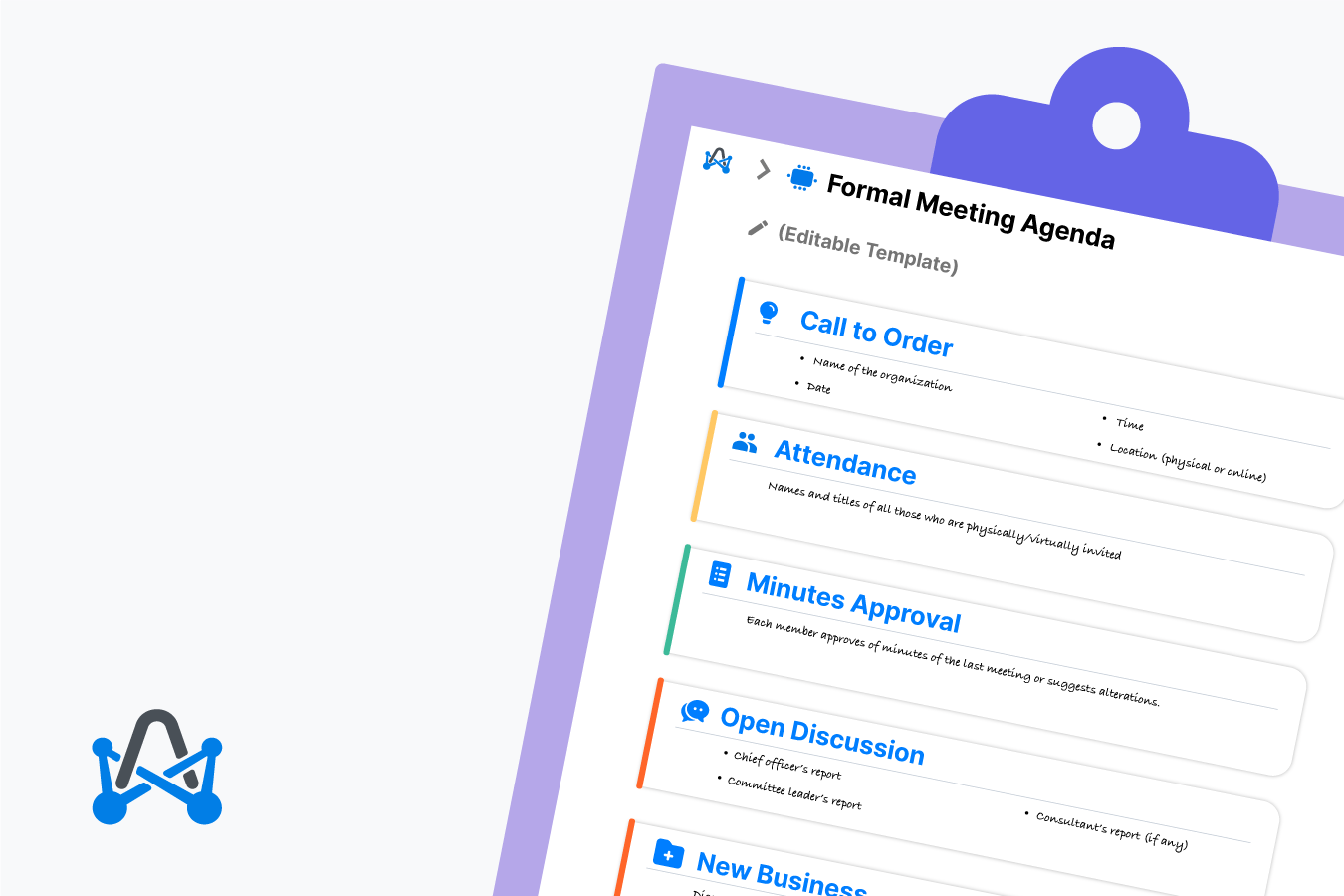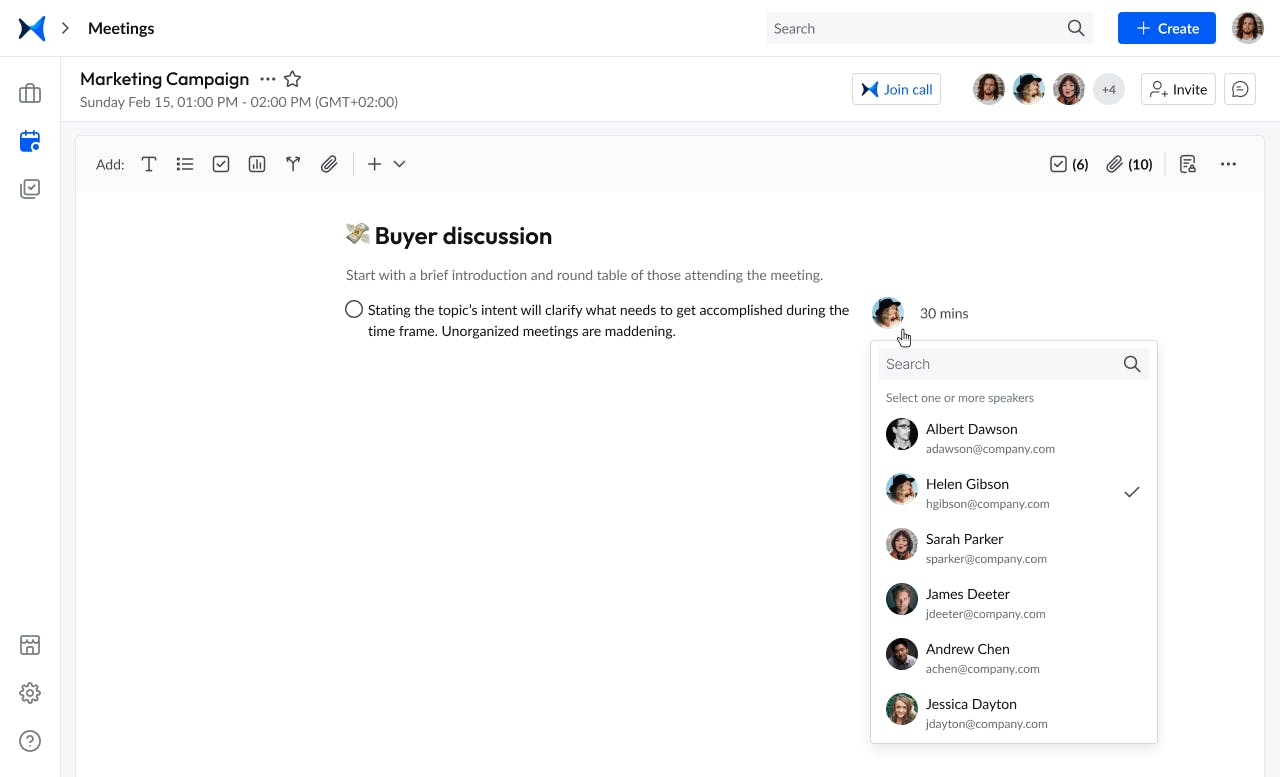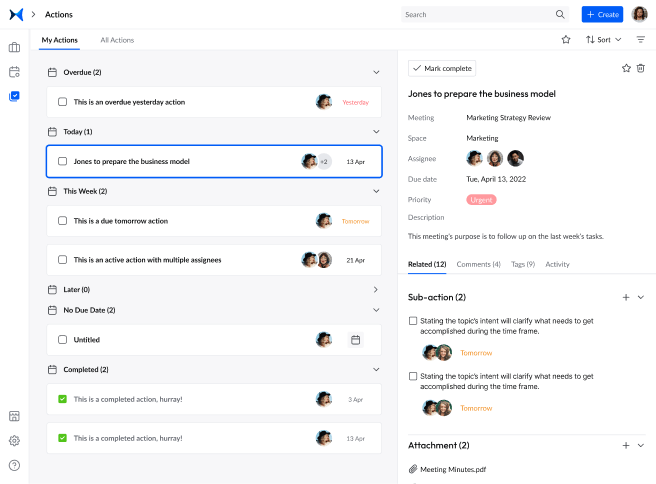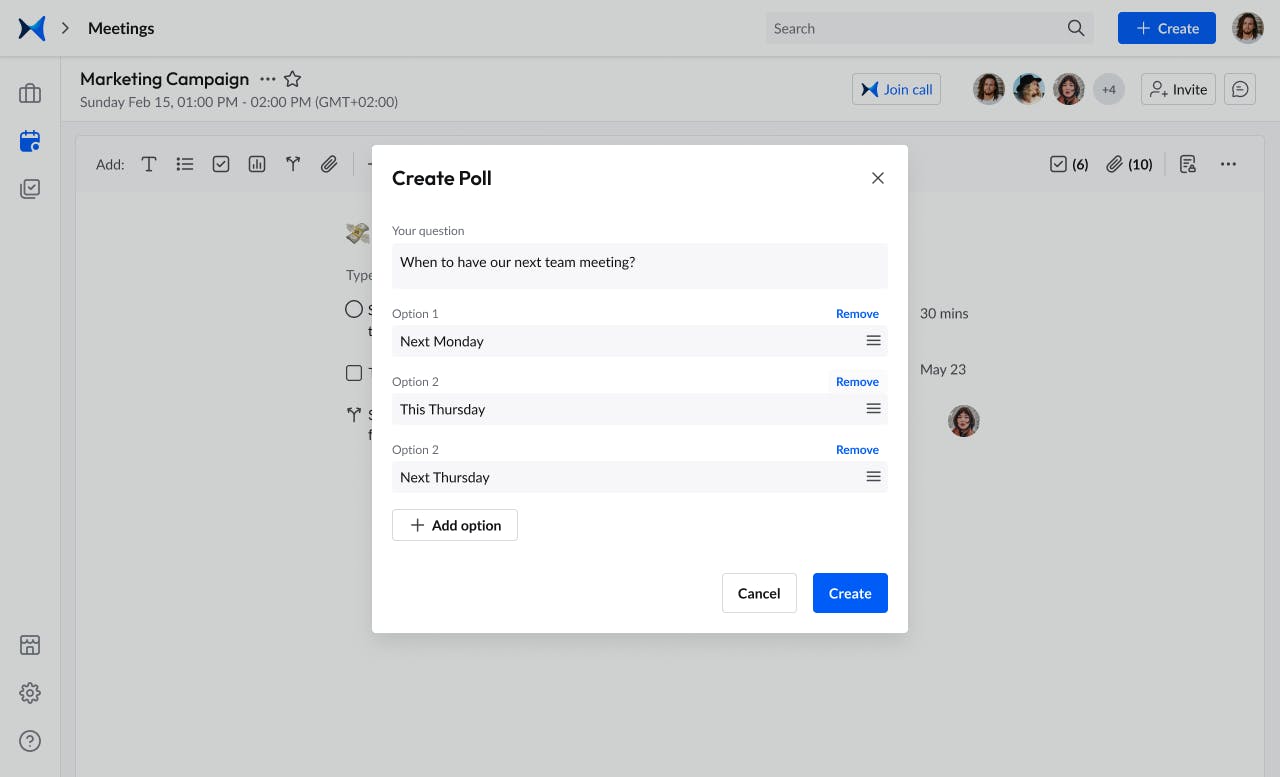August 16, 2022 · 11 min read
This Formal Meeting Agenda Template Is How You Master Formal Meetings

Shaimaa Badawi

A formal meeting may sound like a typical business gathering between managers or staff members, but it's a bit more complicated than that.
These business meetings can be chaotic if not properly prepared for in advance, and the only way to achieve that is by following a formal meeting agenda template.
Let's break it down by defining formal meetings, their purpose, how to structure them, and how to create a well-structured formal meeting agenda template.
What is meant by a formal meeting?
A formal meeting is usually held by top managers of a company where they discuss important matters and make crucial decisions to run the business.
This meeting is prepared by using official documents and an effective meeting agenda that is shared in advance, which is why a formal meeting agenda template is crucial in facilitating these formal meetings.
It can be small or large depending on the topics in need of reviewing and the people involved in the matter, but, in any case, it should be pre-planned and have meeting objectives with definitive rules of order.
A formal meeting agenda template can make the manager's job much easier, but what exactly is the purpose of a formal meeting?
When do managers have a formal meeting?
Top managers and team members have formal meetings when they need to discuss important subjects. The attendees share their insights in a structured manner using specific numbers, statistics, flowcharts, and so on, to make informed business decisions.
When done right, a formal meeting can be engaging and collaborative, and using a formal meeting agenda template can go a long way in ensuring these meetings achieve the desired outcomes.
A formal meeting is conducted so that leaders in an organization are up to speed with progress, risks, and challenges that all teams go through. Anything from projects to company policies is discussed in this meeting following a structured formal meeting agenda template.
What is the structure of a formal meeting?
A formal meeting agenda template provides a clear structure for all parties to follow in a formal meeting. It should be conducted as quickly and efficiently as possible, and you only achieve that if you keep things organized.
1. Set a meeting agenda
The first step is to create a formal meeting agenda and share it in advance to allow people to review the topics and prepare their insights for the meeting.
The formal meeting agenda template should include the topics to be discussed in order of priority and preferably with an assigned time for each talking point.
Use an all-in-one meeting management software platform like adam.ai to organize your formal meeting agenda template using the meeting agenda timer to run a seamless meeting.

Screenshot from adam.ai: The meeting agenda
Transform how you conduct critical meetings—From meticulous preparation to effective execution and insightful follow-up, adam.ai integrates comprehensive analytics, full customization, and intuitive interfaces with powerful meeting management tools.
Easy onboarding. Enterprise-grade security. 24/7 dedicated support.
➕ Don't forget to send a thank you mail after the meeting is finished; it has a positive effect on attendees and enhances meeting productivity.
2. Give each person a role
Each person in a formal meeting should be assigned a specific role to divide responsibilities for maximum time efficiency and accuracy.
These roles include a host, an organizer, a facilitator, a minute taker, and decision makers, and the rest should be well-informed participants in the meeting. The key to an efficient formal meeting is that everyone comes prepared for their role to make a meaningful contribution to the meeting.
3. Assign a minute taker
Recording meeting minutes is crucial in any meetings, especially formal ones, where all parties may need to revisit the decisions, action items, and talking points in the future.
It's way easier to use a meeting management tool that can automatically generate meeting minutes after a formal meeting so that all attendees focus on the discussion.
4. Create action items and decisions
The formal meeting agenda template must include a section for meeting outcomes that include action items and decisions taken during the meeting.
With adam.ai, you can assign action items to the attendees with a click of a button, choose the level of priority, add a deadline for each item, and check it off as completed once it's done.

Screenshot from adam.ai: Assigning and managing actions

Screenshot from adam.ai: Creating a poll
Since we've been talking about formal meetings till now, informal meetings come to mind. So how different do you think an informal meeting is from a formal meeting. Let's find out.
What is the difference between formal and informal meetings?
When you hear about an informal meeting, you may think it's just another ice breaker meeting or a casual get-to-know-each-other meeting. However, informal meetings still mean business, but there are key differences that separate them from formal meetings.
1. Pre-planning
A formal meeting should be conducted like clockwork. Apart from finding a date, time, and location that fits everybody's schedule, there are files to be shared and roles to be assigned to each attendee as explained previously.
A formal meeting agenda template ensures an effective meeting and must be shared with the attendees ahead of time. On the other hand, informal meetings are more flexible and don't require that much pre-planning.
2. Assigning roles
In formal meetings, giving each person a role is crucial; sticking to the formal meeting agenda template means having people take notes, record meeting minutes, organize the meeting, and make the final decisions.
All these roles are not necessary for informal meetings. A meeting host may assign some roles to record ideas in an informal setting or these roles can be interchangeable.
3. Main objective
The main objective in a formal meeting is typically an important topic that needs to be discussed among the top leaders in an organization. Managers gather to decide on pressing matters like budget cuts, business strategies, downsizing, and so on.
In informal meetings, people can still discuss important issues in an ongoing project like tracking progress and resolving problems, but they don't usually make decisions that affect the whole company.
4. Recording minutes
Since formal meetings handle high-stake matters, recording meeting minutes is necessary. This is to hold each person accountable for their role in a formal meeting and to track how every decision was made.
While taking minutes in an informal meeting can still be beneficial, it's unnecessary to track each idea and opinion mentioned in the meeting. Informal meetings usually have a casual tone and even votes on a decision can be taken by a show of hands like in a fist to five strategy.
Knowing the difference between formal and informal meetings helps in crafting a relevant agenda format. To create a formal meeting agenda template, first, you must learn about the types of formal meetings.
What are 5 types of formal meetings?
A formal meeting agenda template can have a specific structure with a few alterations depending on the type of formal meeting. Pre-planning, minute-taking, and agenda format are standard in sample meeting agenda examples for formal meetings, but there are a few items that can be added or removed in each of the five types of formal meetings, so let's find out what they are.
1. Strategy-planning meeting
Managers have a formal meeting every year or quarter to set a plan for the upcoming period. This plan is what all teams in an organization work toward.
A strategy meeting may be held with top- and mid-level managers to decide on the business tactics and vision for a certain period of time.
2. Top-management meeting
A top-management meeting is held at shorter intervals than the strategy meeting. They are usually hosted by the CEO on a monthly basis and include the top-level managers, who review the progress of all departments.
The formal meeting agenda template in this meeting will typically include a section for status updates and decisions to be implemented for the upcoming period.
3. Board of directors meeting
The board of directors meets every quarter or twice a year to gain insights into the company's overall performance.
This information is then shared with the shareholders, which is why the formal meeting agenda template must be well-structured and time-efficient.
4. Shareholders' meeting
A shareholders' meeting is usually conducted once a year and includes all the people who invested in a business. This meeting could be held twice a year if there were grand changes in the organizational structure or strategy to keep these investors in the loop.
The shareholders get the chance to inquire about the company and the managers answer their questions and inform them of past performance and upcoming business strategies.
5. Specialist committee meeting
The board of directors may assign a special committee to resolve a certain issue in the organization. This issue would need proper care and analysis, which can't be handled on a wider scale in a board of directors meeting.
The committee members will be able to meet on a regular basis to work on the challenges assigned to them. They include analysts and experts specialized in the subject matter and they will report back to the board of directors to discuss their progress.
Business meetings may include status updates, performance reviews, retrospective meetings, and kick off meetings, to name a few, and each has a certain type of agenda. Let's take a look at what is included in a formal or business meeting agenda template.
How do you write a formal meeting agenda?
A business or formal meeting is held according to a standard structure outlined in the formal meeting agenda template. This template should be shared with all attendees in advance to give them a chance to prepare for the meeting. So what does a formal meeting agenda template include?
1. Call to order
A formal meeting agenda template includes a call to order, where the meeting host announces the beginning of the meeting.
The exact time, date, and location is recorded and the host may provide a brief introduction and welcome the attendees to the meeting.
2. Attendance
The next step is to record the names of the attendees in the meeting with their roles mentioned in the agenda.
The meeting roles include the meeting facilitator, minute taker, note taker, board members, top managers, and chief officers.
The absentees are also recorded to account for the people voting for decisions, who should be separated from guests who don't vote in the meeting.
3. Minutes Approval
The attendees should review the minutes' report of the last meeting, and then the meeting facilitator should ask all the members if they approve these minutes or if there are changes to be implemented.
4. Open discussion
An open discussion takes place with each officer, committee leader, and consultant mentioning the reports related to their area of expertise.
- An officer delivers their standard report, where a motion may be filed. A discussion will take place to talk about the pros and cons of this motion, after which the voting members will proceed to vote for or against this motion.
- A committee leader shares their report to the members, which tackles a certain issue that was assigned to the specialist committee. The members may or may not discuss this report and then they take a vote on the motion delivered by the committee leader.
- A consultant or specialist may then communicate their opinion on other matters affecting the business.
5. New business
Since the open discussion is about old business and loose ends, the next agenda item is discussing new business plans that should be shared with the group.
Some people involved in this new business will be aware of this information, while others won't, so this part of the formal meeting agenda template is important in keeping everyone up to date with new business objectives and goals for the upcoming period.
6. Special announcements
This part is dedicated to any major announcements like celebrating milestones, mentioning an upcoming event, or launching a new major project.
7. Adjournment
Finally, after all the meeting agenda items are tackled, it's time to adjourn the meeting. The meeting facilitator can wrap up the main motions voted on in this meeting and give people a chance to ask questions.
There's no doubt that having a formal meeting agenda template will aid greatly in organizing your business meetings, but wouldn't it be better if you can manage your entire meeting cycle to run your business more efficiently?
✍️ Use an all-in-one meeting management platform, like adam.ai, to keep your brainstorming meetings organized, with its built-in booking pages. Customize an agenda and capture meeting content, vote on polls and assign actions on meeting attendees, while having the video call itself on adam.ai built-in video conferencing tool, or integrate with your preferred communication platform like Zoom, Google Meet, or Teams. Use Adam the AI meeting assistant to instantly get meeting transcript, smartly highlight key content items, and quickly convert them into actionable items.
More meeting agenda templates
You can find a list of other useful meetings agenda templates on our blog, which can guide you to hold effective meetings:
1. Team meeting agenda template
2. Board team meeting agenda template
3. Quarterly planning meeting agenda template
4. Standup meeting agenda template
5. Status meeting agenda template
6. First meeting with new team agenda template
7. Brainstorming meeting agenda template
8. Skip-level meeting agenda template
9. Kick off meeting agenda template
10. Sales team meeting agenda template
11. Retrospective meeting agenda template
12. Sprint planning meeting agenda template
13. Quarterly business review agenda template
14. One on one meeting agenda template
Bonus. We've recently released "The Future of Meetings Report," where over 490 experts from various industries share their insights on challenges and AI in meetings!
The bottom line
A formal meeting agenda template is the best way to organize your formal meetings. By now, you have all the information you need from the formal meeting's purpose and types to how to structure the meeting and create a formal meeting agenda.
We recommend using an all-in-one meeting management tool to facilitate your formal meetings and make it much more effective and time-efficient.
adam.ai is the ONLY all-in-one meeting management software to organize the entire lifecycle of remote, hybrid, and physical meetings (before, during, and after).
And while there may be multiple meeting management solutions available, here is why adam.ai is the all-in-one meeting management platform you can trust:
- adam.ai is one of Atlassian Ventures' portfolio companies.
- In the meeting management software category on G2, adam.ai has been ranked a leader and a high performer for successive quarters in the past years.
- adam.ai has been included in the Forrester Report in the AI-enabled meeting technology landscape.
- adam.ai is trusted and used by powerful teams and organizations worldwide for all types of critical meetings, like board, committee, project management, and business development meetings.
- And most importantly, adam.ai integrates with your existing workflow, is SOC2 compliant, provides dedicated support and success, and has a free trial option.
Subscribe to adam.ai blog
Stay ahead with the latest insights—get our newest blog posts, tips, and updates sent straight to your inbox.